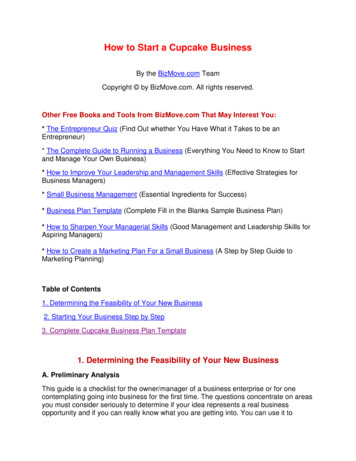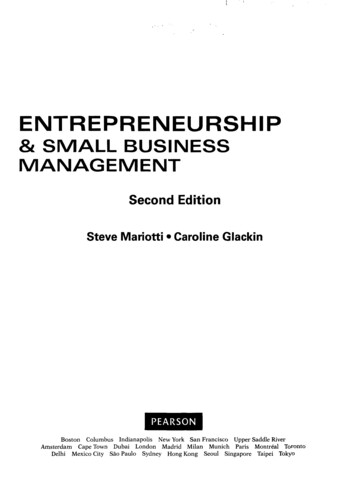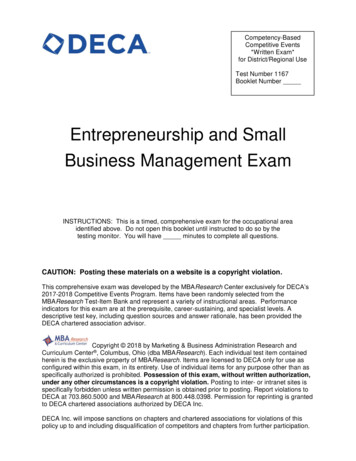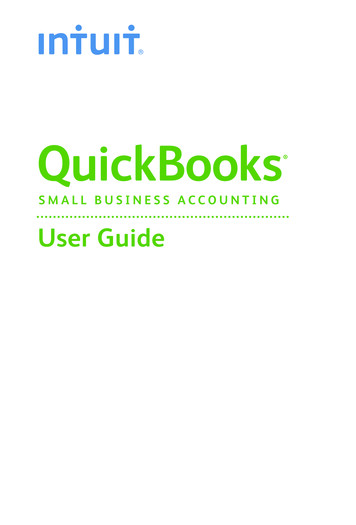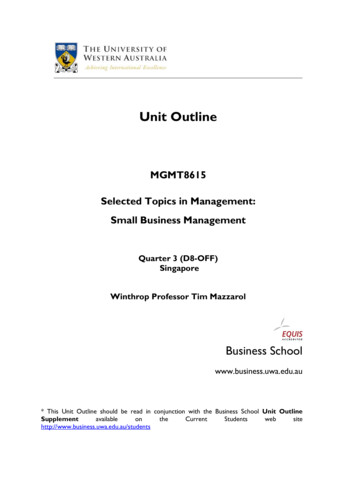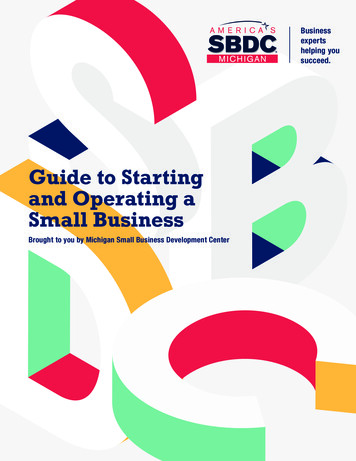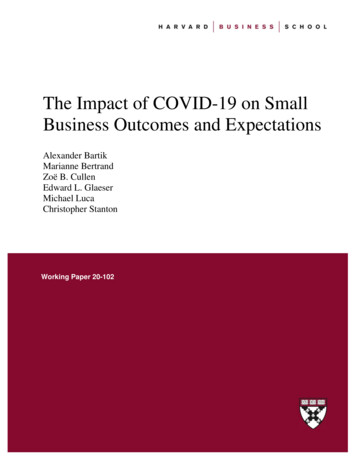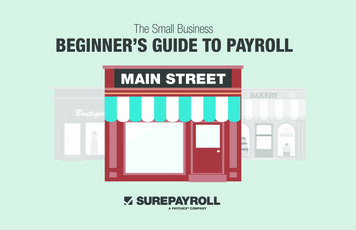
Transcription
The Small BusinessBeginner’s Guide to PayrollMAIN STREET
When you think about whyyou got into business . a lot of reasons might come to mind: a great product or service concept, the ability to be your own boss, flexibility toset your own work-life balance (whether or not this became a reality is another question), a desire to support andcontribute to the local economy . the list can go on and on. What likely doesn’t come to mind is payroll.While payroll might not have been a prominent consideration when you conceived your business, it has likely moved up the listof things you need to worry about as your small business becomes a reality. The truth is that payroll can take up a lot of time,can cause a lot of headaches, and, if not properly handled, can put your business at real risk of jeopardizing employee trust andfinancial stability. But that doesn’t have to be the case.The Small Business Beginner’s Guide to Payroll2WHEN YOU THINK ABOUT WHY YOU GOT INTO BUSINESS
SurePayroll’s Small Business Beginner’s Guide to Payroll willcover the basics that you need to know as you prepare to run your firstpayroll and/or bring on new employees.This guide will serve as a starting point to help you get your payrollgoing, to set it up right from the start, and best avoid hiccups inthe future. We’ll cover: the information you need to run apayroll, employee classifications, how to calculate FICA taxdeductions, and common payroll missteps to avoid. At the endof the guide you will find links to key resources, as well as a worksheetthat you can use to get started and keep track of critical details.“The truth is that payroll can take up a lot oftime and cause a lot of headaches.”The Small Business Beginner’s Guide to Payroll3WHEN YOU THINK ABOUT WHY YOU GOT INTO BUSINESS
A note on payroll taxesPayroll taxes consist of local, state, and federal taxes withheldfrom an employee’s paycheck. The IRS provides an overview ofemployment taxes on its website, making note of:The Small Business Beginner’s Guide to Payroll4nFederal Income TaxnSocial Security and Medicare TaxesnAdditional Medicare TaxnFederal Unemployment TaxWHEN YOU THINK ABOUT WHY YOU GOT INTO BUSINESS
Once you fully understand which taxes to withhold, as well as the rate associated with each one, you’re in position to moveforward. It’s important to note that rates and requirements can differ from employee to employee, based on where they arelocated—an important detail if your small business uses a remote workforce, for example.“rates and requirements can differ fromemployee to employee, based on wherethey are located.”The Small Business Beginner’s Guide to Payroll5WHEN YOU THINK ABOUT WHY YOU GOT INTO BUSINESS
Table of ContentsWHEN YOU THINK ABOUT WHY YOU GOT INTO BUSINESS . 2WHat You Need to Run a Payroll . 7Employee Classifications . 12Payroll Dont’s and How to Avoid Them . 20Is DIY Payroll Right For You? . 23Small Business Payroll Resources . 24The Small Business Beginner’s Guide to Payroll6Table of COntents
What you need to run a payrollThere are several different ways to approach running payroll, whether you do it yourself, use an accountant, leverage an onlinepayroll service, or invest in a payroll software. Regardless of the approach, in order to get your payroll set up and ready to run,there are certain pieces of information you’ll need.Employer Identification Number (EIN) and State Tax IDMuch like you’ll need to collect information from each of your employees (more to come on this shortly), you need tobe prepared with identification information for your business. A business needs a unique identifier. For the purposesof federal filings, each business is required to have an Employer Identification Number (EIN) in order to process payrolland submit payroll taxes.The IRS makes it simple to apply for an EIN online.For some states, an EIN is all you’ll need to file federal, state, and local taxes. For others, you may also need a StateTax ID for your business. To determine if you will need a State Tax ID as well, visit your state tax website.The Small Business Beginner’s Guide to Payroll7WHat You Need to Run a Payroll
Employer InformationRequest that each employee complete FormW-4. With this in hand, you can calculate howmuch federal income tax to withhold fromyour employee’s paychecks. This documentsthe employee’s allowances, as well as theirfiling status. Employees should also completeappropriate state withholding forms.The Small Business Beginner’s Guide to Payroll8WHat You Need to Run a Payroll
DID YOU KNOW?Employment Eligibility: Your employees must also fill out section 1 of Form I-9 by their first day of work,Employment Eligibility Verification. Within three days of the employee’s first day of work, the employer must reviewthe employee’s documentation of identity and work authorization and complete section 2 of Form I-9. This formmust be retained for the longer of three years from hire or one year from termination. Employers must also complywith E-Verify requirements where applicable.Employers are required to comply with federal and state new hire reporting requirements and must report newlyhired employees within 20 calendar days of the date of hire. For each newly hired employee, the employer mustprovide the following to the state new hire directory (specific states may request additional information):Employee: name, address, SSN, date employment began.Employer: name, address, and EIN.If you are outsourcing your payroll to an accountant, online payroll service, or using a software, ask if they handlenew hire reporting for you, or if you will be responsible for completing this yourself.The Small Business Beginner’s Guide to Payroll9WHat You Need to Run a Payroll
Create Your Payroll ScheduleDID YOU KNOW?Payroll frequency determines how often you will runpayroll, and subsequently how often your employeeswill be paid. General frequencies include weekly,bi-weekly, semi-monthly, and monthly. Note that payfrequency is often dependent on state law and/orindustry requirements so you will want to make surethat your schedule is compliant with all applicableregulations for your business.To provide clarity and manage youremployees’ expectations, we suggestcreating a physical payroll calendar that youcan share with them. We’ve rounded upsome best practices for doing so here.Calculate and Withhold TaxesThis is when the payroll process really begins. With each paycheck, it’s your responsibility to calculate and withholdthe correct amount of taxes. Ensuring that your calculations are correct, and that employees understand how to readtheir paystubs, may go a long way toward gaining and maintaining employee trust.The Small Business Beginner’s Guide to Payroll10WHat You Need to Run a Payroll
In the next section, we will cover employee classifications and how to distinguish between exempt and non-exempt employees.A bit later in this guide, we’ll get into FICA calculations and deductions.Quick link: Jump to FICA Tax DeductionsPay TaxesThere are due dates for each type of tax, so make sure you mark theseon your calendar. Missing a due date can result in penalties and/orinterest, not to mention lost time.If you are outsourcing payroll, whether to an accountant, anonline payroll service, or using a payroll software, you shouldinquire about their tax filing process and if they provide any sortof guarantee or remediation in the case of errors.Now that you’re armed with the information you’ll need to get startedwith payroll, let’s cover employee classifications and the differencebetween exempt and non-exempt employees.The Small Business Beginner’s Guide to Payroll11WHat You Need to Run a Payroll
Employee classificationsWhether it’s hiring your first employee, or adding to your team, bringing a new hire onboard is a big step. As asmall business, each new employee is not only a testament to the success and potential of your business, but a significantinvestment of time and financial resources.There are important considerations to think through before you even get to the recruiting and interviewing stages, not the leastof which is determining which employee classification type the role will be: exempt or non-exempt.From a payroll perspective, you’ll need to understand both types of employee classifications. Let’s examine some of thecharacteristics of each.The Small Business Beginner’s Guide to Payroll12Employee Classifications
What It Means to Be an ExemptEmployeeDID YOU KNOW?nAt the federal level, overtime eligibility isdetermined by regulations which are partof the Fair Labor Standards Act (FLSA).“Exempt” employees are those deemedexempt from some or all of the FLSAprovisions, including requirements forminimum wage and overtime pay.nThe broadest category of exempt employees falls under “white-collar exemptions” for administrative, executive,and professional employees, certain computer professionals, and outside sales employees.nExempt employees are generally paid on a salary basis; that is, they receive the same amount of pay each payperiod regardless of the quality or quantity of work performed. They are not eligible to receive overtime pay forhours worked over 40 in a workweek.The Small Business Beginner’s Guide to PayrollIt’s important to note that the exemptionsfrom overtime requirements under the FLSAare based on the specific job duties as wellas the basis of pay for the position.13Employee Classifications
What It Means to Be a Non-Exempt EmployeenNon-exempt employees must be paid minimum wage for all hours worked as well as overtime pay at a rate ofone and one-half times their regular rate of pay for those hours worked over 40 in a workweek.n Differentstates and localities may have stricter policies relating to the calculation and payment of overtime pay.nUnder the FLSA, employees need only pay non-exempt employees for time worked. For example,employers are not required to provide a different pay rate for holidays and are not required to pay non-exemptemployees who do not work a holiday—unless there is an applicable state/local law or employment contractdictating a different rate of pay or paid holiday policy.nNon-exempt employee classifications do often meanmore work for you as the business owner and theperson managing payroll. Why? Because you’ll needto be tracking the hours worked by your non-exemptemployees, and potentially calculate multiple pay ratesper employee for a given pay period.The Small Business Beginner’s Guide to Payroll14Employee Classifications
If you are using payroll services, such as a bookkeeper,accountant, or online payroll provider, you’ll want tomake sure that they can support the payroll requirementsof your business. For non-exempt employees, forexample, you will want to ask about timesheet softwareintegrations, and multiple pay rate support.Now that we’re clear on exempt and non-exemptemployees, let’s touch on some of the most commonpayroll deductions you’ll face, those associated with theFederal Insurance Contributions Act (FICA).The Small Business Beginner’s Guide to Payroll15Employee Classifications
Calculating FICA tax deductionsAs you prepare to process payroll, it’s key that you understand thetaxes associated with the Federal Insurance Contributions Act(FICA). These include:nSocial Security taxnMedicare taxThe Small Business Beginner’s Guide to Payroll16Employee Classifications
DID YOU KNOW?Current RatesThe current tax rate for the Social Security portion is 12.4 percent; while the rate for Medicare is significantlylower at 2.9 percent. The contribution for each is split between the employer and employee; for Social Security,this works out to 6.2 percent each, and for Medicare 1.45 percent each.There is a wage base limit imposed on the Social Security tax. For 2017, the base is 127,200. This is themaximum wage subject to Social Security tax for the year.Also, additional Medicare tax may apply if an employee earns in excess of the threshold amount for that tax year.Employers must withhold an additional 0.9 percent on any wages paid in excess of 200,000.The Small Business Beginner’s Guide to Payroll17Employee Classifications
So how do you calculate FICA deductions?Here’s the information you will need:nThe gross pay for each employee for the pay periodnThe year-to-date gross pay for each employeenThe Social Security and Medicare withholding rates (see above)nThe amount of money deducted from an employee’s paycheck for tax exempt benefitsOnce you calculate FICA taxes for each employee, don’t forget to set aside the same amount for your portion of the taxes.“The contribution for each is splitbetween the employer and employee.”The Small Business Beginner’s Guide to Payroll18Employee Classifications
Did you deduct too much?It’s easy to make a mistake when calculating FICA taxes.In the event that you deduct too much from an employee’s paycheck, youmay have to do one or all of the following:nRefund the over withheld taxes to the employeenFile a new Form 941.nYou’ll want to be sure to correct FICA withholding goingforward, but also maintain the previous inaccuraterecord as a matter of data integrity.Now that we’ve covered the basics of how to process payroll for yoursmall business, let’s discuss some common mistakes to avoid.The Small Business Beginner’s Guide to Payroll19Employee Classifications
Payroll don’ts and how toavoid themWith everything else that goes into running a small business, it can be a challenge to focus the appropriate time, energy, andresources on the payroll process.The bad news: even a small mistake can have major ripple effects.The good news: most of the common small business payroll pitfalls can be avoided.When it comes to payroll missteps, common problems can be divided between setup and maintenance.The Small Business Beginner’s Guide to Payroll20Payroll Don’ts and How to Avoid Them
Upfront MistakesDID YOU KNOW?Proper setup can be the difference between payrollsuccess and failure. For this reason, it’s imperativethat you know exactly what’s required of you, froma compliance perspective.If you are looking to outsource payroll to abookkeeper, accountant, or online payrollprovider, you will want to ask how theystay up to date—and share updates withyou, and whether they offer guaranteesor protections when it comes to payroll,payroll tax compliance and audits.However, with so many regulations and nuances tounderstand and keep track of, it’s easy to make amistake. For example, you might forget to registeryour business for federal, state, and/or local taxwithholdings. Or, it’s possible that you misclassifyemployees, which is a red flag for the IRS or theDepartment of Labor.Solution: familiarize yourself with all the rules, regulations, and laws associated withpayroll. Also, don’t forget to stay current with any changes that could impact yourcompany and/or your employees.The Small Business Beginner’s Guide to Payroll21Payroll Don’ts and How to Avoid Them
Falling BehindJust as important as setting things up right is setting up a payroll process that keeps you on top of deadlines, filings,and requirements on a continuous basis. As noted previously, small business owners are always pressed for time.Subsequently, it’s easy to put payroll on the backburner as you focus on other areas of your business.If you don’t prioritize payroll, you will trigger an avalanche of problems, not least of which is that employees and theDepartment of Labor will not react well to missed pay days.Also, if you don’t pay your taxes on time, you could be subject to penalties on the federal, state, and local levels.Solution: create a payroll calendar to ensure that you never overlook a pay period orimportant tax related date. This can also be shared with employees so that everyone isaware of pay dates and any changes to standard schedules.The Small Business Beginner’s Guide to Payroll22Payroll Don’ts and How to Avoid Them
Is DIY payroll right for you?Although it’s always an option to do your own payroll, as our guide indicates, there is more to this than meets the eye.Are you up to the task of collecting all the necessary information from your employees? Are you okay with the idea that it willtake several hours each pay period to organize your payroll and issue paychecks? Are you familiar with the many taxes you’rerequired to pay and withhold?While this list of considerations can seem overwhelming, there are websites, agencies, and vendors that can help.You didn’t get into business to run payroll, don’t let payroll be the reason you go out of business.At the end of this guide we’ve rounded up some small business payroll resources, as well as a handy worksheet for recordingkey payroll details.The Small Business Beginner’s Guide to Payroll23Is DIY Payroll Right For You?
Small business payroll resourcesIRS Small Business oyment-taxesTo apply for an on-numberein-onlineKey 941.pdfThe Small Business Beginner’s Guide to Payroll24Small Business Payroll Resources
For current FICA rates:https://www.irs.gov/taxtopics/tc751.htmlTips on creating a payroll ions for DIY e/diy-payrollHow to Run Payroll .pdf?sfvrsn 6The Small Business Beginner’s Guide to Payroll25Small Business Payroll Resources
Don’t want the hassle of running payroll on your own?Call SurePayroll to learn about your options:800-900-0781
THE SMAll BUSINESS BEGINNER’S GUIdE TO PAYROll When you think about why you got into business. a lot of reasons might come to mind: a great product or service concept, the ability to be your own boss, flexibility to set your own work-life balance (whether or not this became a reality is another question), a desire to support and contr
